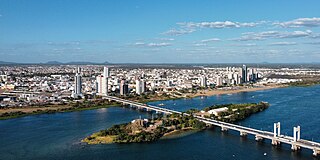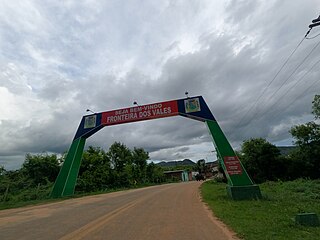
Ilha de Itamaracá is a tropical island and municipality in Pernambuco, Brazil on the Atlantic Ocean. Itamaracá means "stone shaker" in Tupi, from the words itá ("stone") and mbara'ká ("shaker"). It is separated from the mainland by the Canal de Santa Cruz, a salt water channel both mouths of which are on the Atlantic Ocean, and is connected to the mainland by a long road bridge.

Almenara, is a municipality in the northeast of the Brazilian state of Minas Gerais. Situated on the Jequitinhonha River it is the largest city in that river valley. Its 2020 population was estimated at 42,143 and the municipal area was 2,301 km².

Goiana is a city in Brazil in the northeast of the state of Pernambuco, roughly 65 km north of the city of Recife, 51 km from the capital of Paraíba and 2,187 km from Brasília.

Petrolina is a municipality located in the southernmost point of the state of Pernambuco, in Northeast Brazil, in the valley of the São Francisco River. The population was 354,317 in 2020, and the total area is 4,756.8 km2, making it the largest municipality in the state by area. The municipality is closely integrated with Juazeiro, Bahia, located on the opposite bank of the São Francisco.

Igarassu is a city in the Brazilian state of Pernambuco. It is the second oldest city of the country and is situated on the north coast of the metropolitan region of Recife, approximately 32 kilometres (20 mi). It stands as one of the earliest European settlements in Brazil and is the site of the oldest church in the country, the Church of Saints Cosme and Damião, built in 1535. Igarassu is home to numerous colonial-period historic structures. The historic center of the city was designated a national monument by the National Institute of Historic and Artistic Heritage (IPHAN) in 1972.

Cabo de Santo Agostinho is a 448 square kilometer sized municipality located 35 kilometers south of the city of Recife, Pernambuco, Brazil. It is believed by some historians that Vicente Yáñez Pinzón had set anchor in a bay in Cabo de Santo Agostinho on January 26, 1500, however the Portuguese discovery of Brazil was by Pedro Álvares Cabral on April 21, 1500 is officially recognized instead. Cabo de Santo Agostinho was incorporated as a town in 1811.

Tamandarë is a coastal municipality about 103 km (64 mi) south of Recife, the capital city of the Brazilian state of Pernambuco.

Gameleira is a city in Pernambuco, Brazil. The name Gameleira is derived from the large number of Gameleira trees that were growing in the region. The city is 99 km away from Recife, the capital city of Pernambuco. Gameleira has a bus terminal, a public library, two state schools and several municipal schools.

Água Preta is a Brazilian municipality (city) in the state of Pernambuco. It covers 533.33 km2 (205.92 sq mi), and has a population of 37,082 with a population density of 62.05 inhabitants per square kilometer.

Saltinho Biological Reserve is a Biological Reserve near Tamandaré in the state of Pernambuco, Brazil. It contains a sample of the tropical Atlantic Forest biome.

Ipojuca is a municipality in Pernambuco in eastern Brazil. As of 2020 the population according to IBGE was 97,669 and the per capita income (2007) was R$76.418 making it one of the country's highest. The settlement dates to 1560, but the official founding date is 1861 and the community was incorporated as a town in 1864. It is famous for its beaches such as Porto de Galinhas, Muro Alto, Maracaipe.

Sirinhaém is a municipality in Pernambuco with 46,361 inhabitants. The town was founded in 1614 making it among the oldest in the state. The Mayor is Camila Machado Leocadio Lins Dos Santos.

Fronteira dos Vales is a Brazilian municipality located in the north-east of the state of Minas Gerais. Its population as of 2020 was 4,561 living in a total area of 318 km2 (123 sq mi). The city belongs to the statistical mesoregion of Vale do Mucuri and to the statistical microregion of Nanuque. It became a municipality in 1963.
Itapissuma is a city in the state of Pernambuco, Brazil. It is integrated in the Recife metropolitan area with another 13 cities. Itapissuma has a total area of 74.25 square kilometers and had an estimated population of 26,900 inhabitants in 2020 according to the IBGE. The city has the best children's mortality rate in the metropolitan area and has also the second highest GDP per capita after Ipojuca.

Petrolândia is a municipality in the state of Pernambuco, Brazil. It is in the São Francisco Region. Petrolândia has a total area of 1056.6 square kilometers and had an estimated population of 36,901 inhabitants in 2020 according to the IBGE. It has one of the largest GDP per capita of Sertão due to the location of one hydroelectric power plant, property of CHESF.
São José da Coroa Grande is a city in the state of Pernambuco with 21,586 inhabitants. It is southernmost city of the state on the coast section.

Barreiros (Barriers) is a municipality in Pernambuco with 42,764 inhabitants.
Glória do Goitá is a city in Pernambuco, Brazil. It is located in Zona da mata Pernambucana at 75 km of the state capital Recife.
Chã de Alegria is a city located in the state of Pernambuco, Brazil. Located at 54 km away from Recife, capital of the state of Pernambuco. Has an estimated population of 13,556 inhabitants.

Sairé is a municipality located in the state of Pernambuco, Brazil. Located at 110.7 km away from Recife, capital of the state of Pernambuco. Has an estimated population of 9,764 inhabitants.



















